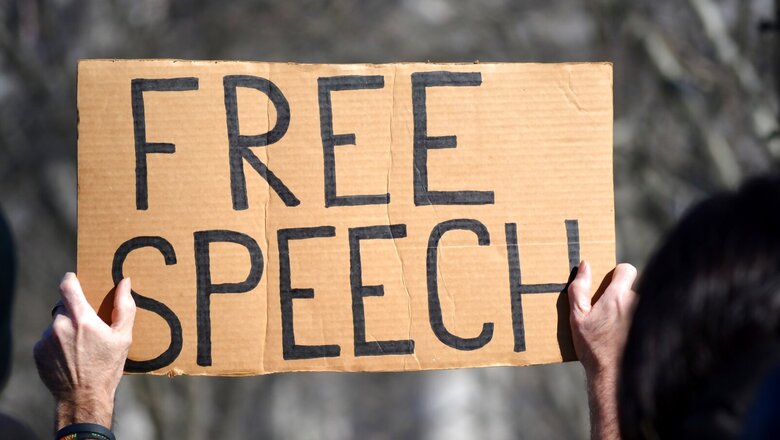
views
The premise of the first part of this series was about how the world has looked at the idea of “Freedom of Expression”. This is the second and final part, dealing with contemporary issues of India relating to FoE.
What Went Wrong With India?
The laws curtailing Freedom of Speech/Expression have a colonial legacy. When Hindu Bharat had encounters with the Islamic world earlier, the imposition of blasphemy law was very much in place. The matter went so much out of hand in the era of Aurangzeb that even celebrating Hindu festivals and observing rituals had been banned.
Records speak for themselves. There was no freedom of religion for Hindus under the rule of musalman rulers even though the Hindu rajas had never opposed any Islamic practices during the initial interactions, except the killing of cows. History is witness that Hindu Bharat became home, with complete acceptance, to all who saw persecution from the rest of the world, be it Parsis, Jews or Syrian Christians, and even the Muslim traders of Arabia, without imposing their own traditions on them.
IPC sections (95, 124A, 153A, 153B, 292, 293 & 295A) were introduced by the British to curtail the Freedom of Expression, only to be further turned draconian by the Congress regime. Of these, 295A is very interesting.
Dr Ambedkar has observed in his book Pakistan or Partition of India (page 169) that in early 1920s, a pamphlet entitled Sitaka Chinala published by Muslims depicted Sita mata as a prostitute. In response, a book titled Rangila Rasul was published which spoke about Muhammad’s private life based on Hadith of Bukhari. The book had mixed reactions. The Anand Bazaar Patrika observed (The Book on Trial: Fundamentalism and Censorship in India by Girja Kumar, page 54) as below:
“The book R. Rasul, which is the subject of the case, is a small brochure written by some anonymous but well-informed author who has tried to draw instances from the life of the Prophet. Those who have read the book know that there is no attempt at ridiculing and the facts put forward in simple and innocent language are entirely based on the writings of standard authors on Islam – both European and Muhammedan.”
But Mahatma Gandhi responded no differently than the current politicians of the day. He writes as below in Young India:
“A friend has sent me a pamphlet called R. Rasul written in Urdu. The author’s name is not given. (…) The very title is highly offensive. The contents (are) in keeping with the title. I cannot without giving offence to the reader’s sense of fine give the translation of some of the extracts. I have asked myself what the motive possible could be in writing or printing such a book except to inflame passion. Abuse and caricature of the Prophet cannot wean a Musalman from his faith and it can do no good to a Hindu who may have doubts about his own belief. As a contribution, therefore, to the religious propaganda work, it has no value whatsoever.”
The very statement was absolutely against the Hindu ethos which lived for ages on the premise of absolute Freedom of Expression and establishing consensus based on debates. The matter was even more interesting looking at the assertion made by ABP, which clearly stated that the pointers in Rangila Rasul go hand in hand with the opinion of Islamic scholars worldwide. Gandhi missed to even condemn the pamphlet which had called Sita a prostitute.
Things had begun to heat up with controversies flaring with each passing day. The government of Punjab had banned the distribution and any further publication. Cases and complaints were filed against Mahashe Rajpal. Interestingly, while the trial was on in court, the Punjab Legislative Council debated the case and concluded as below (The Book on Trial: Fundamentalism and Censorship in India by Girja Kumar, page 50): “The book (…) contained language, which was open to objection, it was (however) decided not to prosecute as there was no ground for thinking that the book had attracted any general attraction.”
On May 4, 1927, Justice Dali Singh of the Punjab High Court in Lahore acquitted Rajpal of the charges. The decision of the judge did not go down well with some critics and threats had become normal (The Book on Trial: Fundamentalism and Censorship in India by Girja Kumar, page 47-49). On July 1 the same year, Muslims, under the leadership of Maulana Mohammad Ali, gathered in huge numbers in front of Jama Masjid, Delhi. What Muslims demanded was a direct threat and The Hindustan Times reported:
“The vast gathering of Muslims declares to the Government with one voice that it should immediately shut down the door now open for the destruction of law and order, ‘by having the judgement immediately revised’. Any further delay in the matter will be an indicator that Government wants to compel the Muslamans to take the law in their hands and such matters like this will precipitate a catastrophe which no forces on earth will be able to check.”
As tensions grew, the Lahore Magisterial Court took up the case against Rajpal and held him guilty, sentencing him to six-month jail. It was then that the ruling party of the day appealed in the court of Judge Singh wherein he concluded that while the malicious nature of the pamphlet was a fact, it was difficult for him to proceed as there was no law against insult on religious prophets.
Rajpal was freed in 1928 (The Book on Trial: Fundamentalism and Censorship in India by Girja Kumar, page 58).
Soon, a new controversy had followed. Risala-i-Vartman, a magazine, published a piece critical of Islam. The Imperial Legislative Council decided that the time had come to amend the criminal law so that it goes in sync with the actions against blasphemy. They came up with the Penal Code Amendment Act XXV of India in 1927, leading to what we currently know as 295A of the Indian Penal Code which states as below:
“Deliberate and malicious acts, intended to outrage religious feelings of any class by insulting its religion or religious beliefs. Whoever, with deliberate and malicious intention of outraging the religious feelings of any class of (citizens of India), (by words, either spoken or written, or by signs or by visible representations or otherwise), insults or attempts to insult the religion or the religious beliefs of that class, shall be punished with imprisonment of either description for a term which may extend to [three years], or with fine, or with both.”
— Indian Penal Code XV, offences relating to religion
On the other hand, things weren’t going to remain simple. Mahashe Rajpal had been suffering assassination attempts right from 1926 only to be finally assassinated on third attempt in Lahore on April 6, 1929. The assassin was a 20-year-old carpenter named Ilm-ud-din (The Book on Trial: Fundamentalism and Censorship in India by Girja Kumar, page 48).
During the trial his case was fought by Muhammad Ali Jinnah who attempted the best but could not save Ilm-ud-din from the death penalty. Some Muslim group came forward to grant Ilm-ud-din the title of “Ghazi” & “Shahid”.
Eventually, a film was produced in Pakistan honouring the ‘Ghazi’ Ilm-ud-din (The Book on Trial: Fundamentalism and Censorship in India by Girja Kumar, page 47). While Mahatma Gandhi condemned it, he went on to place this murder in the bouquet of bomb blasts done by Bhagat Singh and associates. Gandhi declared in his essay in Young India on April 18, 1929, that both acts followed the “same philosophy of mad revenge and impotent rage”. By doing so, Mahatma Gandhi had indirectly justified the murder of Rajpal in the backdrop of condemning the great Bhagat Singh. These types of false equivalences have been the trend with politicians all along.
The situation has not changed even a bit, and many have tried to compare terrorists of Kashmir with the revolutionary Bhagat Singh.
The law had come in place which would go on to assassinate the ethos of Bharat, which very much relied on the absolute “Freedom of Expression” to criticise, discuss, and debate matters related to divinity, spirituality, gods, and goddesses.
From Gandhi to Nehru to Indira, each of them did their best to curb the FoE and all of them only contributed to ‘Talibanise’ Bharat more and more.
In recent times, we have seen things get worse. The post-poll violence in West Bengal was a direct attack against choosing a particular political ideology. When it comes to religious discourse, things haven’t been rosy either. Beheadings and extra-judicial steps have turned vogue.
Kamlesh Tiwari’s throat was slit because he said something about the Prophet. Kishan Bharwad was shot dead because he showed Krishna Bhagwan as superior to Jesus and Muhammad. Nikita Tomar was murdered because she rejected the offer to convert to Islam for marriage. Kanhaiya Lal was beheaded just because he chose to support an alleged blasphemer in a social media post.
When Kamlesh Tiwari made the statements about Prophet Muhammad, around 1 lakh Muslims congregated in Muzaffarnagar demanding death penalty for or beheading of Tiwari. Similar sentiments were echoed for Rajpal nine decades ago.
Mandirs have been desecrated and Milli Gazette even justified the killing of Hindu kar sevaks in the Godhra train burning. The greatest of the artists, MF Hussain, did see it as a right under Freedom of Expression to paint Hindu goddesses nude. Yet none of the Hindus went on the streets and made calls like “Sar Tan Se Juda”.
Hindus did break their silence but refrained from choosing the non-Indic path. They took to the courts under IPC 295A. But I fear the future.
Right from the instances of Rajpal to Kamlesh Tiwari, it has been clear that when it comes to blasphemy related to Islam, nothing except killing of blasphemer shall work. Note the case of the AIMIM MLA calling for the hanging of an alleged blasphemer. Thousands of people have shown up on streets echoing the sentiment. But despite advancements like CCTV cameras, no substantial action has been taken as a deterrent.
I see a big challenge ahead of us. First, to put a full stop to any desire for extra-judicial demands. The use of 295A is too silly and non-Indic in my eyes. Given that the youngest Abrahamic fraternity in India has been using 295A and threatening extra-judicial actions too, the situation seems very dangerous. With Hindus being new entrants into the business of exercising 295A, the matter is going to become even more complex. Making the application of 295A a trend will make us a society where various dharmik sampradayas may begin to apply this colonial law against each other.
The diversity among the sampradayas is so huge that there always exists a fear that things will slowly graduate into intolerant action in the form of 295A. Recently, we saw a film poster showcasing Kaali Mata holding a pride flag and sporting a smoke. Later, an MP from TMC went onto comment on Maa Kaali.
As a FoE absolutist, I would have stood with both, but unfortunately, they were the same people who wanted an alleged blasphemer of Islam to face prosecution with immediate effect. They are the people who see FoE as the best practice only against Hindu Dharma and choose to curtail FoE once someone takes on the monolith walls of the two of the youngest Abrahamic faiths.
Even in Islamic states, one dares not to criticise Islam or say a word against the Prophet though FoE is absolute if you target Dharmik faiths. They are not messiahs of FoE but Hindu haters cherishing the jewel of hypocrisy. Unfortunately, no politician in India vouches for absolute free speech.
The people of Bharat must come forward and ask the state to do away with draconian, medieval era, Roman-in-taste laws like 295A. Until criticism of religions isn’t brought out in the open, our civilization will keep heading to become another monolithic Abrahamic echo-chamber.
“In the great religion of secularism, lies the mighty temple called ‘liberal democracy’ and on the altar of sacrifice, only the head of Hindu has to shine so bright.”
Aabhas Maldahiyar is an architect and an author. The views expressed in this article are those of the author and do not represent the stand of this publication
Read all the Latest News and Breaking News here




















Comments
0 comment